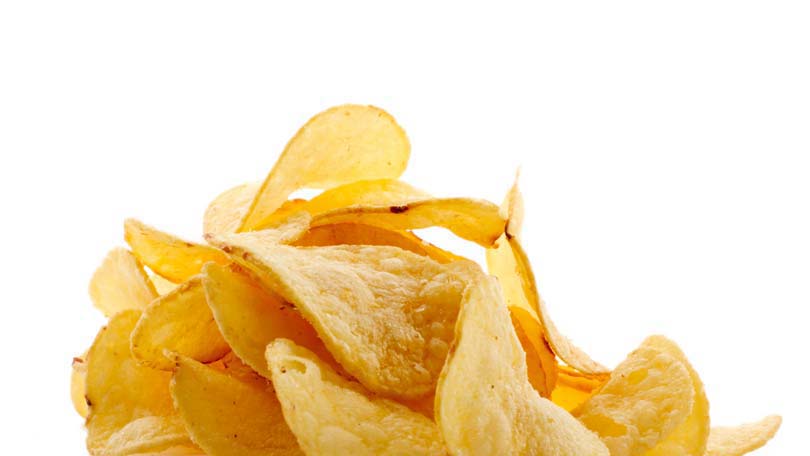
When you think about a great snack or “treat” that both kids and grown ups adore there has to be two distinct ideas that pop into your head. For those “sweet tooth” members out there it would have to be the idea of candy, particularly chocolate. And for those of you out there who “crave” salt with every primitive desire in your body it would have to be the idea of your favorite taste bud savior, the almighty Potato Chip, which comes to mind. Nothing beats biting into a nice crisp potato chip and feeling the rush of salt on your tongue and the “crackle” of thinly baked or fried potato cuts as you crush the chips with your jaw. Lays Potato Chip Company cleverly touted the phrase “I bet you can’t eat just one.” And boy did they ever hit the nail on the head with this catch phrase because, as we all know, when it comes to potato chips they are one of the hardest things to put down after you start into them. Even just sitting here and writing about them I am getting extremely hungry as I think about the different varieties of “CHIP” out there. From your classic ruffled potato chips, to ketchup chips, to all-dressed chips with dip, to Pringles from the can, and into the realm of “chips” that aren’t even made from potato parts such as my personal favorite “Doritos” and nachos, and sun-chips. Wow, what a great tasting snack these types of chips all are. I know some might argue that they are not the healthiest thing for you however, but some chips are better than others. So let’s take a bite out of the chip world and figure out when the first potato chips came to be, how they are made, and look at whether or not they are that bad for you.
A potato chip in its simplest form is a thin slice of a potato that is either deep fried or baked until it is crisp. The first time a “potato chip” seems to have made it’s way from the kitchen to being only greasy fingers on the man who just consumed them was on August 24th, 1853 when chef George Crum (who was working in an area near Saratoga Springs, New York) became fed up with a customer who kept sending back his fried potatoes back to the kitchen because they were too “thick” and “soggy”. In retaliation to this Crum ended up slicing the potato so thin that the food could not be eaten with a fork. However, the customer was so pleased with this new potato creation that the “potato chips” Crum created quickly became a regular item on the lodge’s menu where he worked. They were listed under the name “Sarasota Chips” and their popularity quickly spread throughout New England. In 1910, the potato chip was no longer just a specialty of certain restaurant kitchens as the first ever potato chip production company was launched in the United States.
When chips were first produced on a wide reaching basis they were not stored in the fancy plastic bags that are used today. No, in fact, at first chips were stored in barrels or tins and then in the 1930’s the first sealed bad was created by Laura Scudder in the U.S. when she ironed two pieces of wax paper together, which created an airtight seal that would keep chips fresh until opening. This invention was a huge boost for the chips industry. Another huge boost came in the 1950’s when Joe “Spud” Murphy and his Irish company TAYTO was the first man to make the genius move of bringing seasoning into the potato chip world. His first two flavors “Cheese and Onion” and “Salt ‘n’ Vinegar” would be the beginning of a great development in chip history, with “Salt ‘n’ Vinegar” still being one of today’s most popular and classic chip tastes.
The fact that the worldwide sales volume of “potato chips” is around 30 billion dollars per year would point to the fact that many people are consuming these little devils at a regular basis. Now, the next question to ask is what kind of health concerns can their consumption create?
Besides the salt and fat content problems that potato chips can cause or contribute to there is also a more recently publicized health risk that has to do with potato chips. No I am not talking about “Trans Fats”, as they are by now, as shown by the media, obviously not healthy for us (you can find lots of information on these factors on the web and other media sources). But rather I am talking about “acrylamide”. I wanted to warn you about this chemical compound as I am not sure how much information there is out there concerning it. Acrylamide is formed when starchy foods are baked or fried at very high levels. It is considered a cancer causing agent and its level in potato chips is quite high. Recent legislation in the U.S. is trying to push for potato chip companies to be required to label their chip products with a warning about the high acrylamide levels that are contained in the bag. Some chip companies products exceed current U.S. standards for the labeling of whether or not a product contains acrylamide with acrylamide levels that are upwards of 150 to 910 times greater than the standard set down for labeling to be required. And until recently this knowledge was not really brought to the public. This is crazy to me and in actuality it makes me less likely to eat chips, or at least as often. The choice is up to you whether you enjoy them everyday or simply snack occasionally, just remember that they can be quite addictive. And now that you know a little bit more about their history it should help you with your decision. Happy snacking!





